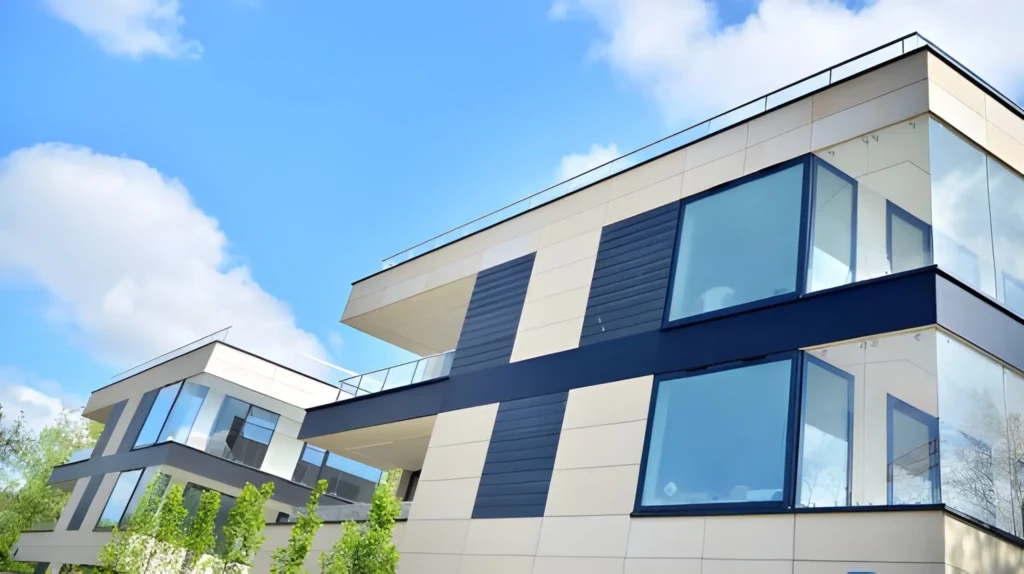These systems integrate multiple layers—each with specific functions—that work together to control water, air, vapor, and thermal energy. Building performance data shows that well-designed cladding assemblies can reduce energy consumption by 30-40% while preventing the moisture-related failures that account for roughly 80% of building envelope problems. External cladding systems represent a complete approach to building envelopes rather than just surface materials bolted to walls. The difference between a cladding system and simple siding comes down to how all the components coordinate to manage the physical forces constantly acting on buildings. Getting this right from the start saves substantial money and headaches over a building’s lifetime.
Rainscreen Principles and Why They Matter
The rainscreen concept fundamentally changed how we think about cladding. Instead of trying to create a perfect water barrier at the exterior surface, rainscreen designs accept that some water will get past the outer layer. The crucial innovation is the air gap between cladding and the water-resistive barrier behind it.
This gap serves multiple purposes. Water that penetrates the cladding hits the inner barrier and drains down without getting trapped. Air moving through the cavity carries away moisture from both rain penetration and interior vapor that migrates outward. Field monitoring of wall assemblies shows that cavity temperatures stay 5-10 degrees closer to ambient than in sealed walls, reducing condensation risk.
Pressure equalization across the rainscreen cavity eliminates the driving force that pushes water through joints and fastener holes. When pressure inside the cavity matches outside pressure, wind-driven rain can’t be forced through small openings. This principle works best with compartmentalized cavities, though even simple vented cavities provide significant benefits.
Layer-by-Layer System Components
The structural wall provides the base and carries building loads, but it’s not the weather barrier. Wood or steel framing with sheathing creates the substrate, but modern best practices recognize that sheathing alone doesn’t provide adequate water or air control.
Water-resistive barriers have evolved from basic building paper to sophisticated membranes. Self-adhering membranes create redundant protection at vulnerable areas like windows and penetrations. Vapor permeability ratings matter—you want barriers that stop liquid water but allow vapor to pass. Materials with perm ratings of 10-50 typically work well, blocking bulk water while allowing drying.
Insulation placement critically affects system performance. Continuous insulation outboard of the structure eliminates thermal bridges through framing members. This approach can improve effective R-values by 25-35% compared to cavity insulation alone. Thickness options range from 1 to 4 inches depending on climate zone requirements and cost considerations.
The ventilation cavity creates the rainscreen functionality. Minimum depths of 3/4 inch allow adequate airflow, though some systems use up to 1.5 inches. Vertical furring strips or specialized rainscreen battens maintain this gap while providing attachment for the cladding. Top and bottom vents allow air movement—blocking either end defeats the system.
Thermal Performance Through System Design
Heat moves through walls in three ways: conduction, convection, and radiation. Cladding systems address all three mechanisms. Continuous insulation blocks conductive heat transfer through solid materials. The air cavity reduces convection when properly detailed. Reflective barriers can address radiative heat transfer in hot climates, though this is less common in residential work.
Thermal bridging through metal fasteners and framing creates weak points in insulation. Advanced systems use thermal break clips or specialized fasteners that minimize conductive paths through the insulation layer. Testing shows these details can reduce thermal bridging losses by 40-60% compared to standard through-fastening.
Thermal mass in the cladding material itself can moderate temperature swings. Heavier materials like fiber cement or masonry store heat during the day and release it slowly, reducing peak heating and cooling loads. This effect is most beneficial in climates with large diurnal temperature ranges.
Air Leakage Control and Energy Loss
Air leakage accounts for 25-40% of heating and cooling energy loss in typical buildings. Cladding systems contribute to air control but aren’t the primary barrier. The water-resistive barrier or a dedicated air barrier behind the cladding should be the airtight layer.
Sealing transitions and penetrations requires meticulous attention. Every window, door, pipe, and electrical box creates a potential leak path. Proper sequencing of air barrier installation around these elements determines whether the system performs as designed. Blower door testing measures whole-building air leakage—targets under 3 air changes per hour at 50 Pascals represent good performance.
Continuous air barriers work better than fragmented approaches. Running the air control layer continuously around the building envelope without breaks or gaps eliminates leak paths. This requires coordinating foundation, wall, and roof transitions carefully.
Durability Improvements from System Approach
Materials last longer when protected from moisture cycles. Keeping structural components dry prevents rot, corrosion, and degradation. Long-term studies of building failures consistently show that moisture-related problems dominate, accounting for roughly 80% of envelope failures.
Drainage and drying capacity in the system assembly determines longevity. Materials that occasionally get wet aren’t necessarily problematic—materials that stay wet fail. Ventilation behind cladding allows drying between rain events, preventing sustained moisture exposure.
Redundancy in water management provides insurance against inevitable imperfections. Primary water control at the cladding surface backed by secondary protection at the water-resistive barrier means that small failures don’t cascade into major problems. Single-layer approaches lack this forgiveness.
Also Read-Why Are Beach Love Quotes So Inspiring for the Heart?



